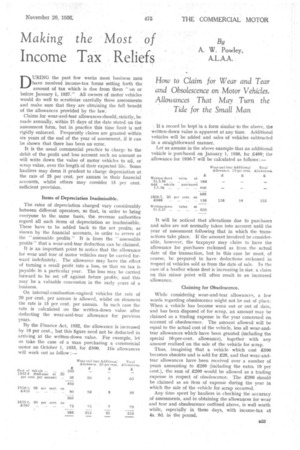Making the Most of
Page 37

If you've noticed an error in this article please click here to report it so we can fix it.
Income Tax Reliefs
By
A. W. Powley, A.L.A.A.
How to Claim for Wear and Tear and Obsolescence on Motor Vehicles. Allowances That May Turn the Tide for the Small Man DURING the past few weeks most business men have received income-tax forms setting forth the amount of tax which is due from them " on or before January 1, 1937." All owners of motor vehicles would do well to scrutinize carefully these assessments and make sure that they are obtaining the full benefit of the allowances provided by the law.
Claims for wear-and-tear allowances should, strictly, be made annually, within 21 days of the date stated on the assessment form, but in practice this time limit is not rigidly enforced. Frequently claims are granted within six years of the end of the year of assessment, if it can be shown that there has been an error.
It it the usual commercial practice to charge to the debit of the profit and loss account such an amount as will write down the value of motor vehicles to nil, or scrap value, over the length of their expected life. Some hauliers may deem it prudent to charge depreciation at the rate of 25 per cent, per annum in their financial accounts, whilst others may consider 15 per cent. sufficient provision.
Items of Depreciation Inadmissible.
The rates of depreciation charged vary considerably between different operators, so that, in order to bring everyone to the same basis, the revenue authorities regard all such items of depreciation as inadmissible. These have to be added back to the net profits, as shown by the financial accounts, in order td arrive at the " assessable profits." It is from the " assessable profits" that a wear-and-tear deduction can be claimed.
It is an important point to notice that the allowance for wear and tear of motor vehicles may be carried forward indefinitely. The allowance may have the effect of turning a small profit into a loss, so that no tax is payable in a particular year. The loss may be carried forward to be set off against future profits, and this may be a valuable concession in the early years of a business.
• On internal-combustion-engined vehicles the rate of 20 per cent. per annum is allowed, whilst on steamers the rate is 15 per cent. per annum. In each case the rate is calculated on the written-down value after deducting the wear-and-tear allowance for previous years.
By the Finance Act, 1932, the allowance is increased by 10 per cent., but this figure need not be deducted in arriving at the written-down value. For example, let us take the case of a man purchasing a commercial motor on October I, 1933, for £500. His allowances will work out as follow — If a record be kept in a form similar to the above, the written-down value is apparent at any time. Additional vehicles will be added and sales of vehicles subtracted in a straightforward manner.
Let us assume in the above example that an additional vehicle is purchased on January 1, 1936, for £400; the allowance for 1936-7 will be calculated as follows — It will be noticed that alterations due to purchases and sales are not normally taken into account until the year of assessment following that in which the transactions take place. If the amount involved be considerable, however, the taxpayer may claim to have the allowance for purchases reckoned as from the actual date of the transaction, but in this case he must, of course, be prepared to have deductions reckoned in respect of vehicles sold as from the date of sale. In the case of a haulier whose fleet is increasing in size a claim on this minor point will often result in an increased allowance.
Claiming for Obsolescence.
While considering wear-and-tear allowances, a few words regarding obsolescence might not be out of place. When a vehicle has become worn out or out of date, and has been disposed of for scrap, an amount may be claimed as a trading expense in the year concerned on account of obsolescence. The amount allowed will be equal to the actual cost of the vehicle, less all wear-andtear allowances which have been granted (including the special 10-per-cent, allowance), together with any amount realized on the sale of the vehicle for scrap.
Thus, imagining that a vehicle which cost £500 becomes obsolete and is sold for £20, and that wear-andtear allowances have been received over a number of years amounting to £280 (including the extra 10 per cent.), the sum of £200 would be allowed as a trading expense in respect of obsolescence. The £200 should be claimed as an item of expense during the year in which the sale of the vehicle for scrap occurred.
Any time spent by hauliers in checking the accuracy .of assessments, and in obtaining the allowances for wear and tear and obsolescence outlined above, is well worth while, especially in these days, with income-tax at 4s. 9d. in the pound.




























































































